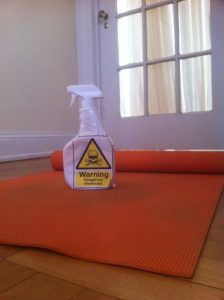TOXIC YOGA MATS
I discovered yoga ten years ago, when I was going through a difficult life passage. It was months of anguish. My then-boyfriend, now-husband finally said, “Time for you to fix yourself. I’m calling the ashtanga center downtown to send you a teacher.”
My first yoga teacher Laura soon arrived. My first few lessons were an initiation into the humiliation of twisty pain. I got to meet myself: all the stuck muscles, organs, nerves, and joints where I wasn’t breathing, where I wasn’t conscious.
But yoga did the trick. There was no place in adhomukha svanasana or ardha chandrasana for fixating on the ups-and-downs of my life. Yoga is a brilliant pattern interrupt, and within a few weeks, my outlook on life had improved.
A few months later, another light bulb clicked on over my head. I was watching Laura demonstrate triangle pose, and the graceful consciousness with which she let her straight back leg pull her front body forward until she clasped her big toe spoke to me. I got it: there was a better way. A better way to move. A better way to feel. A better way to live. My practice of yoga was born in that moment.
Mine is a common story. People go to yoga to feel better, to breathe more fully, and, yes, to work toward that delicious, lithe, tricepy yoga body. We go to know ourselves more fully. We go to detox, both mentally and physically.
So it was with great, unpleasant surprise that I recently discovered my yoga studio smearing industrial strength cleaner on yoga mats between classes.
Pure Yoga, owned by Equinox gym, opened up on the upper West Side of Manhattan about a year before I wandered in. Again, I was trying to heal myself: I’d struggled through low thyroid function before a holistic doctor put me on Armour thyroid. I felt better and I wanted to lose the weight and get back in shape. I wanted my body to feel supple and agile again. I wanted the clean energy yoga instills.
Pure Yoga offers a range of terrific classes, and most teachers are skilled, respectful, and thoughtful about the body. The facilities are gorgeous. Equinox, and the decorator, went to pains to design a yoga studio that emphasizes peace and calm and that evokes everything ‘sattvic’ or pure about yoga and meditation.
When I joined, I was told, “You don’t need to bring your own mat. We provide them, and our mats are clean.” I took that at face value.
That was my mistake. While Pure does regularly wash its mats in machines, sometimes the cleaning people just spray the mats. I happened to see them doing so on a busy Saturday, when there probably wasn’t time to take up the mats between classes.
Curious, I wandered in and picked up one of the spray bottles. ‘Industrial Strength Cleaner’ read the label.
“You’re spraying this toxic stuff on mats that people are going to be right on top of for an hour?” I asked, appalled. The guy shrugged and mumbled something.
Class was about to start; I didn’t have time to peruse the ingredients. I took a rolled-up mat out of a wall bin and hoped it had actually gone through a washing machine. I also hoped there weren’t any pregnant women in the class. As a general principle of looking out for pregnant women (having had three children myself), I didn’t want them pressing their exposed flesh into the stew of chemicals that had been smeared around the mat’s surface. The flesh on the inside of the arms is particularly permeable, and poses like child’s pose and dolphin pose, among others, call for arms outstretched, pressing into the mat.
I was right to be concerned. Dr. Linda Hillebrand, with a practice in Brentwood, California, who has studied and consulted regarding environmental toxicity, said:
- Cleaning supplies are some of the most toxic products and certain chemicals can pose health and/or environmental risks. There are “less toxic” commercial cleaning products now available. However, because manufacturers are not required to list all of their ingredients, unless they are active disinfectants or known to be potentially hazardous, it can be challenging to sort through all of these products.
- Read the labels and avoid harmful ingredients whenever possible. Some of these ingredients are: Nonyphenol ethoxylates (NPE’s) which, when released into the environment, break down into toxic substances that can act as hormone disrupters, potentially interfering with reproduction. Antibacterials in cleaners may cause local (skin and eye) irritation, and certain types, such as triclosan, may contribute to antibiotic resistant bacteria. Some studies also suggest that triclosan could form dioxin, a carcinogen in the presence of sunlight and chloroform, a probable human carcinogen, in the presence of chlorinated water.
- Ammonia is poisonous when swallowed, extremely irritating to respiratory passages when inhaled, and can burn the skin on contact. Butyl cellosolve(butyl glycol, ethylene glycol, monobutyl) is a lung tissue irritant and is poisonous when swallowed. Chlorine Bleach (Sodium Hypochlorate) causes irritation to lungs and eyes. If chlorine and bleach are mixed, they can form a dangerous gas that can severely damage the lungs. D-limonene can cause skin irritation. Diethanolamine (DEA) and Triethanolamine (TEA) can produce carcinogenic compounds which can penetrate the skin when combined with nitrosomes (many times used as an undisclosed preservative).
- The term ‘disinfectants’ includes a wide variety of ingredients (such as chlorine bleach, alcohol, quaternary compounds, pine oil, ethyl alcohol), some of which are regulated by the EPA as pesticides. Hydrochloric acid can severely burn skin and irritate the eyes and respiratory tract. Naptha can cause headache, nausea, central nervous system symptoms with overexposure. Petroleum based ingredients (surfactants), also includes formaldehyde, a carcinogen. Phosphatesare toxic to the environment.
- Best advice is to research the products or better yet—make your own cleaning products.
In fact, my first response was to ask to research the ‘Industrial Strength Cleaner’ so I would know exactly what Pure Yoga proposed that I lie on, inhale, and absorb. After class, I went to the desk to speak with the manager, to ask permission to take a photo of the bottle label so I could do the research.
A desk attendant suggested that industrial strength cleaner wasn’t actually in the bottles labeled ‘Industrial Strength Cleaner.’ She said, “Maybe they just use those bottles, but that’s not what’s in them.” I suppose it is possible that the industrial strength cleaner, which is not free but must be purchased, was dumped out so that Pure Yoga could spray the mats with something non-toxic, something ‘pure.’
Anything is possible.
The manager finally emerged. Her immediate response was to stonewall and to cast me as an agitated client. I was polite and calm, but I did repeatedly ask for the opportunity to take a photo so I could research the ingredients. She refused, saying, “I’m just trying to work with you.”
“If you’re trying to work with me,” I answered, “then you’ll permit me to photograph the bottle label so I can research the ingredients and see if they’re toxic.”
But she was in full cover-up mode. No permission was forthcoming. I told her that I would blog about this episode. “Do you realize that pregnant women are lying on the chemicals in that cleaner, and possibly absorbing those chemicals through their skin into their bloodstream to pass on to their unborn children?”
“Go ahead and blog,” she said scornfully.
But there’s more than toxic chemicals at stake here. Dr. Debra Jaliman, a dermatologist with a busy practice and author of the popular book Skin Rules: Trade Secrets from a Top New York Dermatologist (St. Martin’s Press, March, 2012) said this about yoga mats: “In my practice I’ve seen a variety of infections from yoga mats. Bacterial infections are the most common, like impetigo and boils. I have even seen MRSA staph infections. I have also treated athlete’s foot, which is a fungal infection, plantar warts, and herpes. The best thing would be to bring your own mat, but if not, rubbing alcohol is a good way to sanitize a mat without toxic chemicals.”
Perhaps regulations require yoga mats to be sanitized with certain chemicals. If so, it’s my feeling that an establishment that promotes itself as ‘pure’ must disclose those chemicals to their patrons. We deserve to know. Hiding the truth from well-intentioned yogis who go to yoga to detox is not ethical.
But the bottom line is: bring your own yoga mat. Even a studio that takes pains to promote its purity may well be hiding something toxic.








